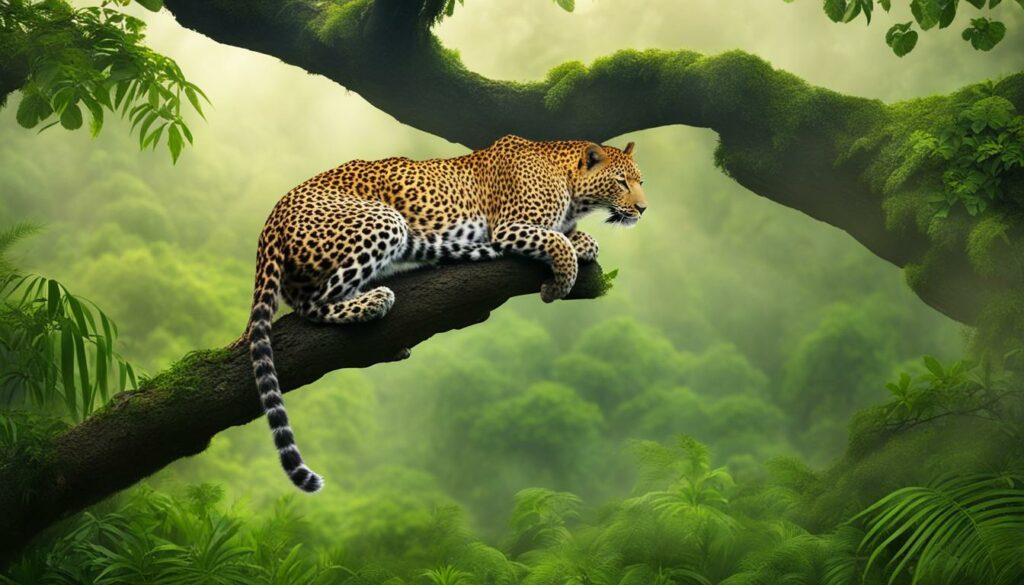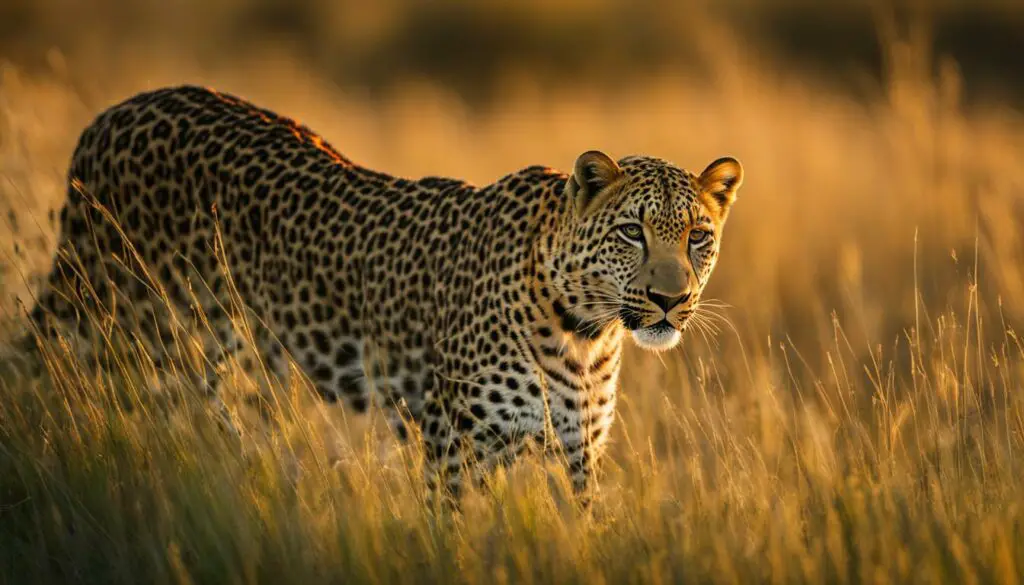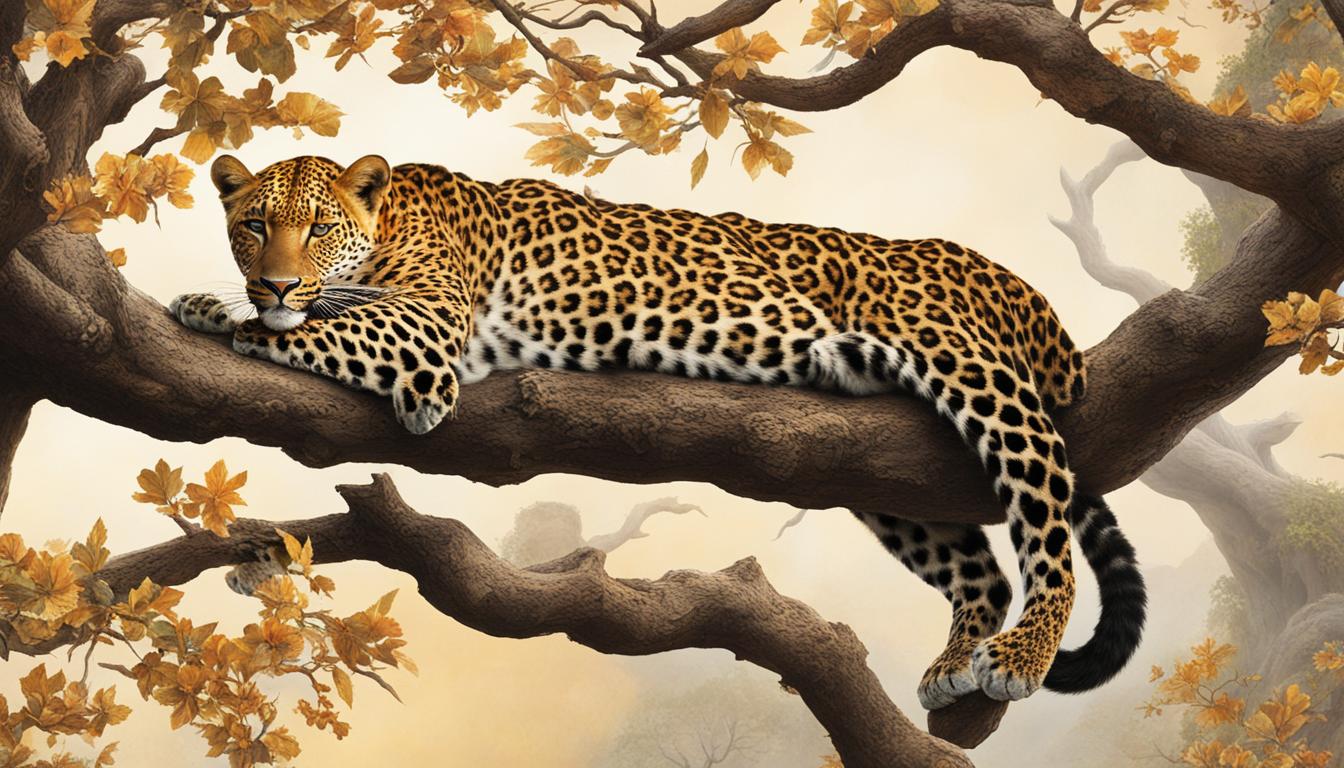Leopards are truly fascinating creatures with a multitude of unique characteristics. Their light-colored fur adorned with dark spots, known as “rosettes,” is a remarkable feature that distinguishes them from other big cats. Did you know that there are also black leopards with nearly invisible spots? These magnificent animals can be found in various regions of the world, including Sub-Saharan Africa, northeast Africa, Central Asia, India, and China.
One of the most impressive traits of leopards is their unmatched speed. They can sprint up to 58 km/h, making them formidable predators in the animal kingdom. With their powerful hind legs, they can leap up to 6 meters in a single bound. It’s no wonder they are such successful hunters!
Leopards are known for their solitary nature, preferring to spend their time alone. They mark their territory using scratches on trees, urine scent marks, and feces as a warning to other leopards. Despite being solitary animals, they have a varied diet that includes bugs, fish, antelope, monkeys, rodents, deer, and more. Their incredible climbing abilities allow them to scale trees effortlessly, where they can protect their prey from scavengers.
Stay tuned to discover more fascinating facts about leopards in the upcoming sections!
The Impressive Climbing Abilities of Leopards
Leopards are renowned for their remarkable climbing prowess. With strong muscles and retractable claws, these big cats are well-equipped for scaling trees with ease. Whether it’s for resting during the day or securing their prey, leopards utilize their impressive climbing abilities to their advantage.
After a successful hunt, leopards often carry their kill up into the trees, strategically stashing it at heights of up to 50 feet. This behavior not only prevents other animals from stealing their meal but also allows leopards to enjoy their food without interruptions. Their agility and strength enable them to drag their prey up to these elevated perches, showcasing their adaptability in different environments.
Leopards’ climbing skills also play a vital role in their hunting strategies. With the ability to navigate through trees with precision, leopards can effortlessly ambush their prey from above. This vantage point gives them an advantage, allowing them to silently stalk their target before launching a swift and precise attack. Their climbing abilities, combined with their stealth and agility, make them formidable predators in their habitats.
The Impressive Climbing Abilities of Leopards
| Aspect | Description |
|---|---|
| Tree Resting | Leopards often rest on tree branches during the day, utilizing their climbing skills to find safe and comfortable perches. |
| Kill Stashing | After a successful hunt, leopards will drag their prey up into the trees, stashing it at heights of up to 50 feet to protect it from scavengers. |
| Hunting Strategy | Leopards use their climbing abilities to ambush prey from above, silently stalking their targets before launching a swift and precise attack. |
Leopards’ impressive climbing abilities are not only a testament to their physical prowess but also a key factor in their survival and hunting success.
The Size and Speed of Leopards
Leopards are known for their impressive combination of size and speed. Despite being the smallest of the big cats, they are incredibly fast runners. Females typically weigh between 46 to 132 pounds, while males are around 50% larger, weighing 80 to 165 pounds. With a body length ranging from three to six feet (excluding the tail), leopards possess a compact yet powerful build that enhances their agility and hunting prowess.
When it comes to speed, leopards can reach impressive velocities. These magnificent creatures are capable of running up to 36 miles per hour, enabling them to quickly close in on their prey or escape potential dangers. Alongside their remarkable acceleration, leopards are exceptional jumpers. They can leap up to 20 feet in a single bound and jump 10 feet straight up in the air, showcasing their explosive power and versatility in navigating their surroundings.
The combination of size and speed makes leopards formidable predators. Their agility allows them to swiftly maneuver through various terrains, while their speed enables them to pursue and capture agile prey with precision. This unique blend of physical attributes contributes to the survival and success of leopards in their habitats.
| Species | Average Weight (pounds) | Average Length (feet) | Top Speed (mph) |
|---|---|---|---|
| African Leopard | 46 – 132 | 3 – 6 | 36 |
| Indian Leopard | 80 – 165 | 3 – 6 | 36 |
| Snow Leopard | 60 – 120 | 3 – 4.5 | 35 |
The Distribution and Habitat of Leopards
Leopards can be found in a wide range of habitats, including rainforests, savannas, woodlands, and desert edges. They are distributed across Africa and Asia, with various subspecies existing in different regions. These regions include sub-Saharan Africa, northeast Africa, Central Asia, India, and China. However, their populations have been significantly reduced due to habitat loss and urbanization. Leopards are adaptable and can thrive in different environments, but their survival is threatened by human encroachment on their habitats.
Table: Leopard Distribution by Region
| Region | Subspecies |
|---|---|
| Sub-Saharan Africa | Leopard Panthera pardus pardus |
| Northeast Africa | Leopard Panthera pardus pardus |
| Central Asia | Leopard Panthera pardus ciscaucasica, Leopard Panthera pardus saxicolor |
| India | Leopard Panthera pardus fusca |
| China | Leopard Panthera pardus japonensis |
Leopards are adaptable to different habitats within these regions. In sub-Saharan Africa, they can be found in a variety of ecosystems, including grasslands, woodlands, and even mountainous areas. In Central Asia, they inhabit montane forests and alpine meadows. In India, leopards are known to inhabit both deciduous forests and the dense rainforests of the Western Ghats. The Chinese leopard, found in northeastern China, primarily resides in temperate forests.
Despite their ability to adapt, leopards face significant challenges due to habitat fragmentation and destruction. Deforestation, urban development, and encroachment on their territory have led to declining populations in many areas. Conservation efforts are crucial to protect the habitats of these majestic creatures and ensure their long-term survival.

The Solitary Nature of Leopards
Leopards are known for their solitary nature and spend most of their time alone. They mark their territory using scratches on trees, urine scent marks, and feces to warn other leopards to stay away. While males and females may cross territories for mating, they typically avoid each other in other circumstances. Leopards are independent animals and do not form social groups like some other big cats. This behavior allows them to have their own space and resources without competition.
Leopards’ solitary behavior is not just a result of their territorial nature; it also contributes to their hunting success. By being solitary animals, leopards minimize the risk of competition for food and increase their chances of survival. They can focus entirely on hunting and securing their prey without the need to share or defend their catch.
Additionally, the solitary nature of leopards enables them to maintain a lower profile, making them less detectable by potential threats. By avoiding large social groups, they reduce the risk of being spotted by predators or prey. This stealthy approach allows leopards to surprise their prey and increases their chances of a successful hunt.
The Solitary Nature of Leopards in Comparison to Other Big Cats
| Leopard | Lion | Tiger |
|---|---|---|
| Solitary nature | Form prides | Can be solitary or live in groups |
| Mark territories using scratches, urine, and feces | Mark territories using scent and roaring | Mark territories using scent markings |
| Independent hunters | Cooperative hunting in prides | Independent hunters |
As seen in the table above, leopards demonstrate unique characteristics compared to other big cats. While lions form prides and tigers can exhibit both solitary and social behaviors, leopards maintain their independence and prefer a solitary lifestyle. These distinctions highlight the diverse behaviors and adaptations among big cat species.
The Versatile Diet of Leopards
Leopards have a diverse and adaptable diet, allowing them to survive in various habitats. These big cats are opportunistic hunters and are known to eat a wide range of animals. Their diet includes insects, fish, antelope, monkeys, rodents, and even deer. Leopards are skilled predators and can take down prey much larger than themselves.
One interesting aspect of their diet is their ability to hunt and consume different types of prey depending on their location and available resources. In areas with larger populations of smaller animals, leopards will primarily feed on these abundant species. However, in regions with a higher concentration of larger prey, such as antelope or deer, they will focus their hunting efforts on these animals instead.
This versatility in their diet is crucial for their survival, as it allows them to adapt to changing environments and ensure a steady food supply. By being able to exploit a variety of food sources, leopards are able to thrive even in habitats with limited resources.
Table: Example of Leopard Diet Variations
| Location | Primary Prey | Secondary Prey |
|---|---|---|
| Savanna | Antelope | Warthogs, Gazelles |
| Rainforest | Monkeys, Rodents | Duikers, Birds |
| Desert | Jackals, Lizards | Hares, Snakes |
In conclusion, leopards have a varied and adaptable diet, allowing them to thrive in different habitats. Their ability to hunt and consume a wide range of prey species is essential for their survival. By understanding the versatility of the leopard diet, we gain insights into the remarkable adaptability of these magnificent big cats.
The Unique Characteristics and Behaviors of Leopards
Leopards possess a range of unique characteristics that make them stand out among other big cats. With their distinctive communication methods and agile climbing abilities, these predators are truly remarkable.
Distinctive Communication
Leopards have developed a language of their own, using distinctive calls to communicate with other members of their species. One notable sound they make is a hoarse cough, which they use to alert neighboring leopards about their presence. Additionally, they growl when angry and purr when content, expressing their emotions through vocalizations.
Agile Climbing Abilities
Leopards are renowned for their exceptional climbing skills. With their strong muscles and retractable claws, they effortlessly navigate through trees and often spend their day resting on branches. When leopards make a kill, they will often drag their prey high into the trees to keep it safe from scavengers. This behavior showcases their ability to adapt to different environments and protect their food resources.
Stealthy Hunting Tactics
Leopards are masterful hunters, employing stealth and precision in their pursuit of prey. They stalk their victims silently, relying on their keen senses and camouflage to remain undetected until they are within striking distance. With a sudden burst of speed, leopards pounce on their unsuspecting targets, securing a successful hunt. This combination of patience, agility, and calculated tactics makes them formidable predators.
Leopards’ unique characteristics and behaviors contribute to their adaptability and success as predators. Their distinctive communication methods, agile climbing abilities, and stealthy hunting tactics distinguish them from other big cats. By understanding and appreciating these remarkable qualities, we can gain a deeper insight into the lives of these incredible creatures.

Conclusion
Leopards are truly remarkable creatures, with a multitude of fascinating facts that make them stand out among the big cats. From their beautiful fur patterns to their impressive climbing abilities, leopards showcase the wonders of nature. Their size and speed, combined with their agility and stealth, make them formidable hunters and allow them to thrive in various habitats.
But while we marvel at their unique characteristics, we must also recognize the challenges they face. Habitat loss and human encroachment threaten their survival, emphasizing the need for conservation efforts to protect these magnificent creatures. By understanding and appreciating the incredible traits and behaviors of leopards, we can foster a greater sense of responsibility towards their preservation.
In conclusion, leopards are more than just fascinating animals – they are vital components of their ecosystems. By learning about these incredible creatures, we can inspire a sense of awe and respect for the natural world around us. So let us take action to ensure the continued existence of leopards and preserve the wonder they bring to our planet.
Can you provide some interesting facts about leopard reproduction as well?
Leopard reproduction is a fascinating process. Female leopards typically give birth to two or three cubs after a gestation period of around 90 to 105 days. Cubs are born blind and rely on their mother for nourishment and protection. Male leopards play no role in raising their offspring.
FAQ
What are some interesting facts about leopards?
Leopards have light-colored fur with dark spots called “rosettes,” they can run up to 58 km/h, and they are skilled climbers.
What are the impressive climbing abilities of leopards?
Leopards are skilled climbers and often rest on tree branches during the day. They have strong muscles and retractable claws that allow them to climb with ease.
What is the size and speed of leopards?
Leopards are the smallest of the big cats, with females weighing between 46 to 132 pounds and males being around 50% bigger, weighing 80 to 165 pounds. They can run up to 36 miles per hour.
Where are leopards distributed and what is their habitat?
Leopards can be found in various regions of the world, including Sub-Saharan Africa, northeast Africa, Central Asia, India, and China. They inhabit habitats such as rainforests, savannas, woodlands, and desert edges.
What is the solitary nature of leopards?
Leopards are known for their solitary nature and spend most of their time alone. They mark their territory to warn other leopards to stay away and typically avoid each other in other circumstances.
What is the versatile diet of leopards?
Leopards have a varied diet and will eat bugs, fish, antelope, monkeys, rodents, deer, and more. Their adaptable diet allows them to survive in different habitats.
What are the unique characteristics and behaviors of leopards?
Leopards have a unique language of communication, climb trees and stash their prey there, and use stealthy hunting tactics. They also have distinctive calls and are known for their agility.
Conclusion
Leopards are fascinating creatures with unique characteristics and behaviors. They play an important role in their ecosystems, but their survival is threatened by habitat loss and human encroachment. Learning about leopards can help us appreciate and protect these incredible big cats.











